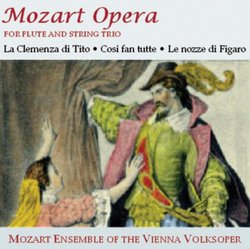| All Artists: Wolfgang Amadeus Mozart, Vienna Mozart Ensemble Title: Mozart Opera for Flute and String Trio Members Wishing: 0 Total Copies: 0 Label: Nimbus Records Original Release Date: 1/1/2007 Re-Release Date: 4/10/2007 Genre: Classical Styles: Opera & Classical Vocal, Chamber Music, Historical Periods, Classical (c.1770-1830) Number of Discs: 1 SwapaCD Credits: 1 UPCs: 0710357580529, 710357580529 |
Search - Wolfgang Amadeus Mozart, Vienna Mozart Ensemble :: Mozart Opera for Flute and String Trio
 | Wolfgang Amadeus Mozart, Vienna Mozart Ensemble Mozart Opera for Flute and String Trio Genre: Classical
"The Bohemian musician and composer Johann Went (or Jan Wendt) was a wind player in the Imperial Harmonie (wind band) in Vienna, for which he arranged selections from many operas... It is all very agreeable and elegant,... more » |
Larger Image |
CD Details
Synopsis
Album Description
"The Bohemian musician and composer Johann Went (or Jan Wendt) was a wind player in the Imperial Harmonie (wind band) in Vienna, for which he arranged selections from many operas... It is all very agreeable and elegant, and beautifully played and recorded ... One needs to imagine oneself in Demel's on the Kohlmarkt in Vienna enjoying an Einspanner (Viennese coffee with cream) and providing one's own musical background." -- Ivan March, Gramophone This is a companion volume to NIM 5576, which included highlights from Die Zauberflöte, Don Giovanni, and Die Entführung aus dem Serail. By performing in Austria and abroad, the Mozart Ensemble of the Vienna Volksoper has established itself in the Viennese concert culture and with music lovers all over the world. The "Concerts in Mozart's House" take place at the monastery of the "German Teutonic Order," where Mozart lived and worked for Archbishop Colloredo in the year 1781. The "Sala Terrena" is the oldest concert hall in Vienna, where Mozart himself performed many concerts.

 Track Listings (23) - Disc #1
Track Listings (23) - Disc #1